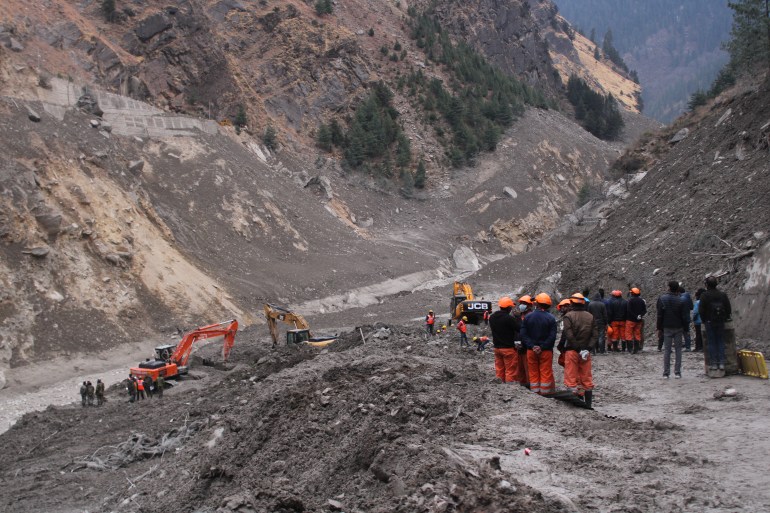‘We thought this is our end’: India villagers on glacier disaster
Families in Uttarakhand state wait desperately to hear about their loved ones trapped in a tunnel as others mourn the deaths and destruction.
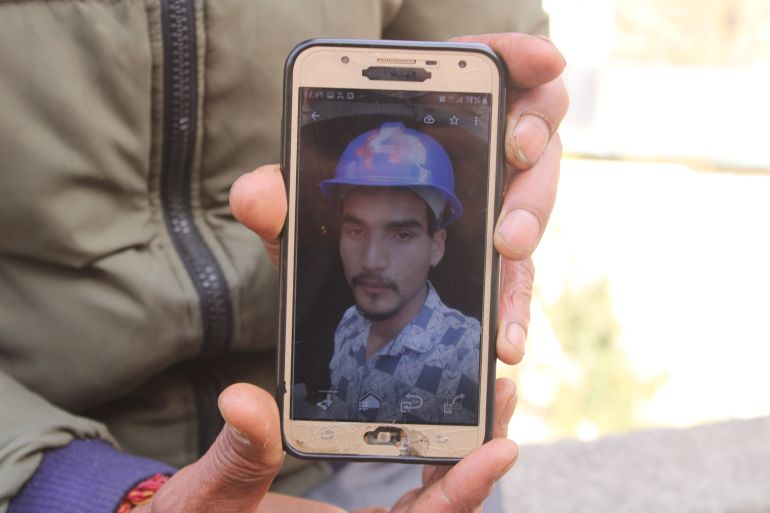
Joshimath, Uttarakhand – On Sunday morning, Rishi Prasad, 57, ran as fast as he could to save his son but he could reach the tunnel where his son was, massive boulders, trees and mud had already blocked its entrance.
Abhishek Panth, 24, was working in an under-construction tunnel near Tapovan Dam, at the confluence of Dhauliganga and Rishiganga Rivers – in Chamoli district about 280km (173 miles) east of Dehradun, capital of the northern Indian state of Uttarakhand.
Keep reading
list of 3 items14 dead, 170 missing after Himalayan glacier bursts in India
Twitter seeks talks with India over order to remove accounts
Panth is among the dozens of people still trapped inside the 2km (1.24-mile) long tunnel, Aparna Kumar of the Indo-Tibetan Border Police (ITBP), which is a part of the rescue operations, told Al Jazeera on Tuesday.
The tunnel is part of the multimillion-dollar, 520-megawatt Tapovan hydroelectric project, one of the two dam projects destroyed on Sunday by a deadly flash flood triggered by a Himalayan glacial burst, which has claimed at least 31 lives so far while some 175 others are missing, according to the Uttarakhand State Disaster Response Fund.
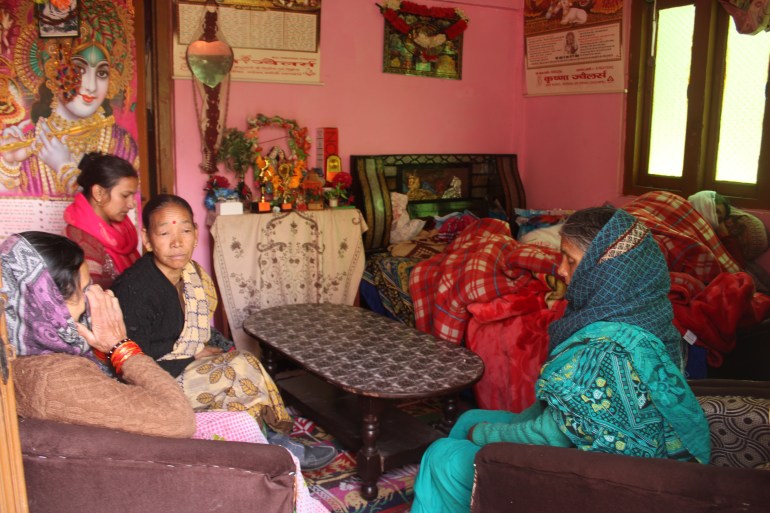
The distraught father, who saw his son leave their home shortly before the disaster, could not hold back his tears. His wife has not spoken since; she lies on a bed with relatives sitting around her, hoping those trapped inside the tunnel are alive.
“I don’t know whether my son is alive or dead,” Prasad told Al Jazeera. “It’s been more than 50 hours now, but the administration has not been able to clear the tunnel.”
Meanwhile, the Rishi Ganga hydel project near Raini village, almost six kilometres from Tapovan Dam, has been completely washed away by the floods caused by the glacier burst.
Officials say over 40 people, who were working at the power station, are either trapped under the debris or have been washed away by the waters. However, relatives of the victims say that the number could be as high as 50.
“The height of water at this location was around 100 meters and one can very well imagine the velocity and impact of that water,” said Ashu Singh Rathore, chief engineer with the Border Roads Organisation – which is carrying out the rescue operation at the site along with teams of NDRF and security forces.
Four bodies were recovered at the site earlier in the day.
‘Not seen such a scene in our lives’
Hundreds of rescue workers, including Indian army personnel, are scouring muck-filled ravines and valleys, looking for survivors at several sites, including the tunnel.
The sounds of choppers and military helicopters making rounds to assist the rescue efforts fill the air.
Balvir Singh Rawat, 32, who runs a shop in Tapovan village, told Al Jazeera that at about 10:30am (05:00 GMT) on Sunday, he heard a loud bang.
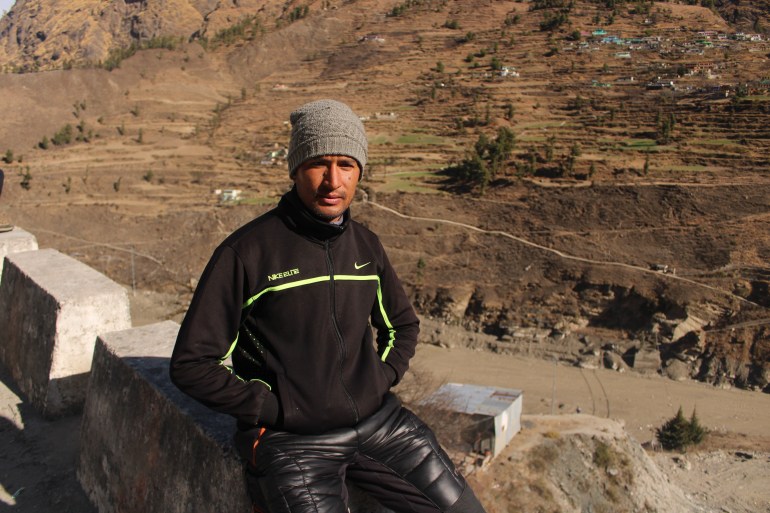
“We thought the whole mountain had broken down,” he said.
“After five minutes, we looked at the river. There was no water but big boulders, trees and mud moving and its level only rising and rising. We had not seen such a scene in our lives.”
Darshan Singh, 58, who runs a tea stall in the same village, adds: “We thought this is our end.”
Singh, who lives in the neighbouring village of Bangool on the other side of the Dhauliganga river, is trapped in Topavan as the bridge over the river has been washed away.
“I don’t know for how many days I will have to stay in Topavan but I’m happy that my family members are safe,” he said.
ITBP’s Kumar said 13 villages are cut off after the flood washed away their bridges.
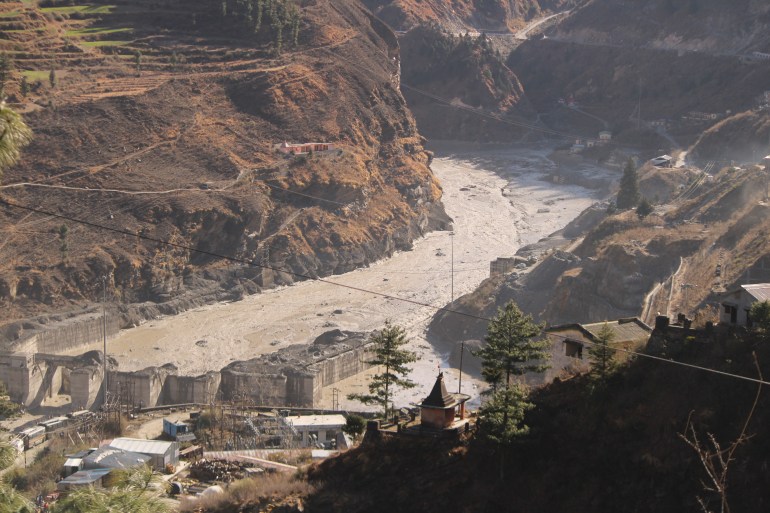
Narendra Lal, 46, worked as a mason at the dam for the past five years. His body was fished out from the river on Sunday night.
Lal is survived by his elderly mother, wife and four children; he was the family’s only breadwinner.
On Tuesday afternoon, dozens of villagers assembled at his modest house on a hill in Topavan to demand that the family be given not only a one-time compensation announced by the government but also a monthly fund to run the household.
Lal’s neighbour Mohan Bajwal asked why he was working on a Sunday when most offices were shut for the weekly holiday.
“Had the company not kept its office open on Sunday, so many people would have been alive today,” he told Al Jazeera.
‘Want this project closed once and for all’
Ram Kishan lost his wife Sarojni Devi and daughter Anjana Semwal, 18, after they were swept away while cutting grass near the river on Sunday. Their bodies have still not been found.
The 52-year-old blamed the hydroelectric projects for the glacier breaking. He told Al Jazeera that the blasting undertaken for the construction had damaged his house and has now taken away two members of his family.
“We are poor people and can’t fight these big corporations but I want this project to be closed once and for all. This is not for our betterment. This is our destruction” he said.
Kishan’s younger daughter Sanjana, 16, told Al Jazeera that she wants to see her mother and sister and for them to have a proper funeral.
“My only appeal to the government is to find my mother and sister.”
The Himalayan state of Uttarakhand is prone to flash floods and landslides. Sunday’s disaster has prompted calls by environmental groups for a review of power projects in the ecologically sensitive mountains.
“In order to construct these hydropower projects, dams and roads, massive blasting was done in these mountains and this is what we see now,” said Om Prakash, 39, a local from Topavan.
Prakash told Al Jazeera the local residents had protested against the projects when they were announced. “But nobody listened to us. Now, here is the result,” he said.
“Our fears are now turning into a reality.”
Appeals to do more
Families of the victims at the Rishi Ganga hydel project allege that the authorities are not doing enough to find their loved ones.
“There are just three machines clearing the debris here and two out of them are primarily there for the road connectivity. The administration is not bothered that almost 50 people are trapped inside this debris,” said Shabir Ahmad Zargar, whose brother Basharat Ahmad was working at the power project and is missing since Sunday.
Ahmad, a resident of Srinagar in the Indian Administered Kashmir was working as General manager at the power project, according to his family.
Rathore of the Border Roads Organisation told Al Jazeera that his organisation’s primary job is to connect disconnected villages with the rest of the state after the flood water washed away the bridge near Raini village.
“We are basically here for connectivity purpose but at the same time on the request of the local administration, our one machine is working where the people are trapped that is why we have been able to recover four bodies today and we are going very slow because any kind of body if we recover, it has to be recovered safely,” he said.
